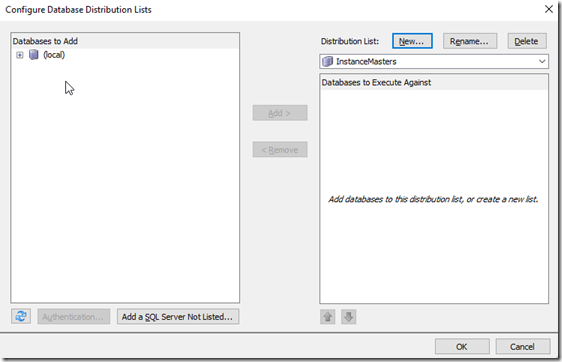SQL Multi Script is a lesser known tool from Redgate Software that is designed to easily allow you to run scripts against many server instances with one click of a button. It’s similar to a Central Management Server, but it returns results a little cleaner, and has a few extra features that make things run better. I have a number of customers using this to deploy to many instances, both for database changes and instance config updates.
The main way to get setup is with a distribution list. This is a list of the instances and database you want to connect to. This post will show how to make one.
The Default List
By default, you have one list, and you can add instances to this. As you can see below, I’ve added a few instance and databases to my list, which is shown on the right side of the main application window.
If I click the “Configure” button, I get a dialog that lets me manage these lists. It is shown below, with a mover in the middle to add or remove databases to the current list. In the upper right is a “New” button to add a list.
Let’s click that. This gives me a simple dialog to add a name. I’ll choose “InstanceMasters” for all the master databases on instances. This is a handy list when I want to add a login to all instances or make a config change.
Once I click “Create” I get back to the mover. This is where I select databases.
I can expand the instance on the left, and see all the databases. One note, the system databases are listed last, so scroll down. I’ll click “Add” in the middle to add this one.
I have a second instance on my machine, so let’s pick that. I’ll click the “Add a SQL Server Not Listed” at the bottom.
I get a connection dialog to specify the name and credentials.
Once I complete this, I go back to the mover and I see my second instance. I’ll add that master database as well.
If I click OK, I now have my distribution list selected and set up. Any scripts I execute will go against these two master databases. If I needed to exclude one of the databases for a script, I could uncheck it, and in the image above, I can change distribution lists with the drop down below the Delete button.
That’s a quick look at lists in SQL Multi Script. The tool lets me run multiple scripts against various databases, execute an ad hoc script, and get all the results with the instance/database name as well.
It’s a very handy tool that not enough people use, so if you have the Toolbelt, give it a try. If down, download a SQL Multi Script evaluation today and see how this can help you in your daily work.








